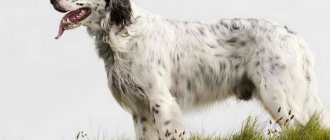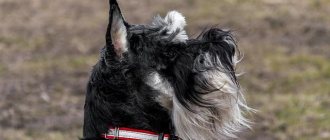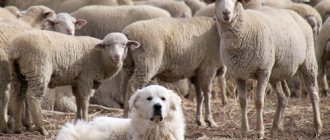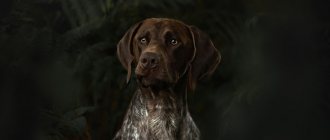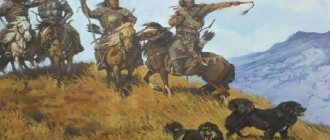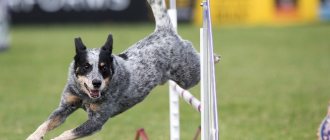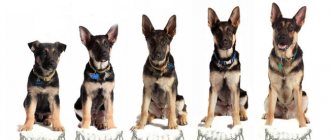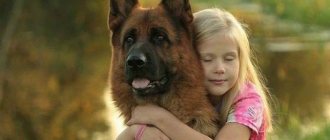| Origin: | USA |
| Usage: | guard and cattle dog |
| Color: | the most common red marble and blue marble |
| Dimensions: | height at withers up to 60 cm, weight of an adult up to 32 kg |
| Lifespan: | 12-15 years |
The Australian Shepherd has a second, no less sonorous name - Aussie. The innate instinct of a watchdog fully demonstrates its protective qualities. Thanks to intelligence, the animal grasps knowledge on the fly, training turns into pleasure for both the owner and the dog. Its easy-going nature and natural kindness make it possible to keep a pet in a family with small children.
Australian Shepherd: brief characteristics of the breed
Aussies were originally bred as a herding dog breed, but they became most popular as family pets and loyal companions. Australians are extremely sociable, friendly and peaceful animals. Aussies are not aggressive and get along well with all pets. Among Australian Shepherds, there are often individuals with heterochromia, when the dog's eyes have different colors, for example, one is blue and the other is brown. This breed has pronounced sexual dimorphism, thanks to which you can easily distinguish a female from a male. Australian Shepherd females reach smaller sizes and have a more graceful physique. Aussies are active and energetic dogs, so they are suitable only for people leading an active lifestyle.
Among Australian Shepherds there are individuals with different eye colors.
Aussie Origin History
These beautiful and strong animals are known as Australian Shepherds, but in fact their homeland is North America.
It was thanks to the efforts of American breeders that the Aussie breed was born, which has an original appearance, amazing endurance and performance.
At the end of the nineteenth century, the active development of cattle breeding began in America and not only European, but also Australian shepherds began to flock to the New World. Naturally, they came accompanied by their faithful dogs, and local cattle breeders appreciated the working qualities and physical potential of these animals.
Farmers have decided to use imported dogs to breed a new breed that would combine all the positive traits of their parents. The best representatives of Basque (Pyrenean) Shepherds, Collies and Bernese Mountain Dogs were selected for selection. As a result of painstaking work, a completely new breed of dog appeared, which was given the name Australian Shepherd, or Aussie for short, associating them with shepherds from the Australian continent.
Very soon, the smart, intelligent and active Aussies began to be used not only to guard livestock, but also in equestrian competitions and rodeos, where they entertained spectators with amazing abilities and funny tricks. During the First World War, Australian Shepherds provided invaluable assistance to American soldiers, acting as messengers.
The Aussie was first registered as a herding and working dog in 1957. But the official recognition of the Australian Shepherd by all canine organizations occurred only at the beginning of the twenty-first century.
Australian Shepherd: description of the breed
Aussies are medium-sized dogs, strong and robust. The height of Aussies varies between forty-five and sixty centimeters. Adult Australians weigh from twenty to forty kilograms.
Appearance of an Australian Shepherd
External characteristics of the breed:
- Animals have a proportional build, the body is flexible and muscular;
- paws are straight, of medium length with oval pads;
- Aussie puppies are born with a short tail and if it is not docked, then in adult dogs it reaches a length of up to ten centimeters and is covered with long hair. But, as a rule, the animal’s tail is docked, leaving a short stump, the so-called “bobtail”;
- Australians have a large head extended towards the nose;
- medium-length ears have a triangular shape;
- Aussies have expressive almond-shaped eyes. Eye color can be bright blue, green or light brown;
- Dogs' fur is long and thick with a dense undercoat. The hair on the head, ears and front legs is shorter than on the rest of the body.
Important: there is a variety of the Australian Shepherd - mini-Aussie. Miniature Australians differ from their larger relatives only in size. The height of the dogs ranges from thirty to forty centimeters, and the weight of the mini-Aussie does not exceed twenty-five kilograms.
On the left in the photo are two representatives of mini-Aussies, on the right are two representatives of Aussies
Aussie colors
Australian Shepherds come in a variety of colors and patterns. The uniqueness of these dogs is that no two Aussies are alike; each has its own unique coat color and body pattern.
The breed standard allows four color options.
Black
The main color of the dogs is black, but red and white markings are acceptable.
Australian Shepherd black color
Red
The body of the Aussie is colored fiery red, sometimes interspersed with white.
Red Australian Shepherd
Blue marble (merle)
The main color of shepherd dogs is gray-blue with a silver tint, interspersed with black, red and white spots intertwined into a bizarre pattern.
Blue merle Australian Shepherd
Red marble
The dogs are colored red or copper-red, and have black and white spots of different sizes and shapes scattered across their bodies.
Red marbled Australian Shepherd
About the breed
The Australian Shepherd is a dog with a bright, rich color. It is characterized by strength, flexibility and moderate muscularity.
- Having an average size, the animal weighs from 22 to 30 kg. The height of males is from 51 to 58 cm, and that of females is from 45 to 54 cm.
- Life expectancy (13-15 years) allows us to classify the breed as a long-livers.
- Color can be: black, marble and red. In pure form or with inclusions.
- The Australian Shepherd breed is highly intelligent. Therefore, give them tasks so that they do not get bored.
The pet will get along well with other family members, children and animals. But he will be reluctant to make contact with unfamiliar people. Therefore, Australian Shepherd puppies are taught socialization from the very beginning.
Character and behavioral characteristics
Affectionate, loyal, sociable and extremely cheerful dogs, and this is not the entire list of positive qualities of Australian Shepherds. Aussies are considered versatile four-legged pets, they are ideal companions, excellent guards and loyal loving dogs that can, without exaggeration, be called part of the family.
These amazing animals have irrepressible energy, they are cheerful and active and are in constant motion. Aussies will never sit in one place; these dogs are constantly busy with some business or work that is important from their point of view. Sometimes it seems to owners that their pets never sleep, because they react to the slightest rustle and any extraneous sound.
The Aussie will happily spend time playing with his owner, accompany him on a morning run, or join him on a bike ride. And if the owner is busy, the hardworking pet will keep himself busy patrolling the area, playing with a ball, or looking after domestic animals such as rabbits and ducks.
Aussies are real fidgets that are suitable only for very active owners.
The Australian Shepherd sincerely loves all family members, but it is the owner who is the center of the universe and the undisputed leader for the dog.
An Aussie always strives to please its owner, and nothing is more important to her than his approval and attention. In the morning, the dog will accompany the owner to the gate and will impatiently await his return. And in the evening he will be the first to meet his beloved owner from work, squealing loudly with joy, wagging his short tail and baring his teeth in a welcoming smile. A dog accurately guesses a person’s mood and adapts to it. The Aussie will share joy with the owner and will be sad in solidarity with him if he is upset or upset about something.
Aussies are very sensitive to the mood of their owner, they can empathize and rejoice with him
Australian Shepherds are responsible, reliable and vigilant guards. Yes, they are friendly and peaceful, they are not characterized by aggression and anger, but this does not mean that animals cannot stand up for themselves or protect their family. Aussies will cope with any assignment of the owner, because for them there are no impossible tasks. Australian Shepherds can be safely trusted to guard your home and surrounding area. They will take care of the safety of a small child, not allowing him to leave the yard and not allowing strangers near the baby. Australians will look after a flock of sheep, goats and cows, and will not allow the animals to run away or stray from the herd.
Representatives of this breed have a stable and balanced psyche, but at the same time they are very emotional and express all their feelings with the help of their voice and various movements. In general, these animals do not tend to vocalize for no reason, and the Australian will not disturb the night's sleep of household members simply because he is bored and wants to attract attention to himself. And if a dog in the yard begins to bark loudly, this means that it has noticed something suspicious and is in a hurry to warn the owner about it. Also, with a loud, loud bark, the vigilant pet will notify the owner of the arrival of guests.
The Aussie breed is distinguished by high intelligence; they are quick-witted and observant, thanks to which they are able to find a way out of any situation.
These insightful and intelligent animals carefully analyze everything they see and hear and instantly find a solution to even the most difficult problem. Australian owners are always surprised how their pet disappears from a locked room or manages to escape from the yard. And everything is very simple - the Aussie carefully watches the actions of the owner in order to repeat them later. Therefore, it is not a problem for a dog to turn a doorknob or open a fence gate to sneak out for a walk. By the way, opening the door of the refrigerator or bedside table to get to your favorite treat is also not difficult for your smart pet.
Australian Shepherds are highly intelligent and castles are not an obstacle for them.
With strangers, the Australian Shepherd behaves warily, but politely. The dog will not take his eyes off the stranger, while keeping a respectful distance. But the Aussie is friendly towards the owner’s friends who often visit their home and greets them with a friendly bark.
Important: Australians are very sensitive to the mood of all household members. They cannot stand quarrels and scandals; it is very important for them that peace and harmony reign in the family. In the event of a conflict between household members, the Aussie will act as a diplomat, running from one family member to another, inviting them to a conciliatory dialogue.
Aussie puppies: maintenance and training
Fluffy and cute Australian Shepherd puppies look like little plush toys. And it is not surprising that the charming baby becomes everyone’s favorite from the first minutes of his appearance in the house. A perky, cheerful and inquisitive puppy will immediately get to know all family members, explore all the rooms in the house and explore the surrounding area.
The little Australian shows a keen interest in all surrounding objects, often tasting them. Therefore, on all things that come into the field of view of a curious pet, traces of his teeth may remain. To protect valuable items from the puppy, they should be hidden in a place inaccessible to him, offering the pet a variety of toys in return, including chewing ones.
When purchasing an Aussie puppy, be prepared for surprises in the form of damaged things and furniture.
In addition, you should teach your child discipline from early childhood and devote time to his upbringing. It is especially important to teach your puppy commands such as “fu” and “no”. It is unacceptable to cruelly punish a puppy for a chewed shoe or a puddle in the wrong place. After all, a severe reprimand is enough for a smart pet to realize his guilt and not do it again.
It is very interesting to watch how an Aussie puppy develops protective instincts from a young age. For example, a baby loves to collect all his toys in one pile and zealously protects them from other pets. Also, the little Australian will readily take on the role of a guardian of small animals, making sure that chickens or rabbits do not escape from the yard.
The puppy needs constant attention, communication and interaction with people. Therefore, it is necessary to work with your pet every day, teach him commands in a playful way and do not forget to praise him for his obedience and intelligence.
Raising and training a puppy will take a lot of time and effort from the future owner, since Aussies are very attached to their owner and require attention
Character traits
As mentioned above, the main character trait of the Australian Shepherd is its developed intelligence - they are designed in such a way that they need constant responsibilities. This is a diligent worker and an excellent service dog - if you decide to have him as a lap/sofa sloth, you will be disappointed.
In the absence of a field for activity, such dogs begin to feel sad or rebel through various rather strange and destructive tricks - puppies are especially guilty of this behavior. Therefore, if you decide to get yourself such a dog, think about what to do with it.
With appropriate upbringing and training, an Australian Shepherd can become an understanding, loyal friend and protector - you can even entrust it with a child, for whom it will become a wonderful nanny.
If you make a short list of character traits characteristic of Aussies, it will look like this:
- Subtle intelligence.
- Excellent dog training ability.
- Flexible character.
- Friendliness.
- Love for children.
- Loyalty.
- Ability to guard.
- High sports qualities.
Among the disadvantages are the need to necessarily offer them regular physical and intellectual exercise, as well as a tendency to be destructive in moments of boredom and idleness. Otherwise, this is an intelligent and loyal breed, with which you can go through serious trials, receiving protection, understanding and support.
Attitude towards children
Aussies have a particularly reverent and tender relationship with children. These beautiful and loyal animals can be owned by families with a child of any age. After all, Australians are very patient, affectionate and careful, and even during active play they will never harm a baby.
The Australian Shepherd has a very stable psyche, so it is not capable of harming a child.
For a small child, the Aussie will become a caring and responsible nanny. The dog will make sure that the baby does not leave the territory of the house and will not allow a stranger to approach him. The pet will calmly accept the fact that a child can pull it by the tail or squeeze it in a tight hug without showing even a shadow of dissatisfaction.
An Australian Shepherd will be a cheerful friend and active play partner for a schoolchild. In the morning, the Aussie will walk the child to the school gate, meet him after school and enthusiastically play football with him or take a walk in the park.
An Australian will be an inseparable companion for a teenager, especially if he plays sports. A hardy and strong dog will run a multi-kilometer cross-country race with him, take part in a bicycle race and accompany him on a hiking trip.
Aussie will monitor the child so that he does not leave the yard
Important: Aussies have one interesting feature: in order to return a lost sheep back to the herd, the dog bites its hind limb. A pet can behave the same way with a baby, so you should immediately explain to the dog the rules for interacting with a child.
Relationships between Aussies and other pets
Australian Shepherds are a breed of dog that gets along well with all pets. In the eyes of an Aussie, another dog or cat is not a rival, but another family member and friend to play with.
A friendly and cheerful Australian will find a common language with almost any non-aggressive dog, be it a miniature Yorkshire terrier or a strict German shepherd. But keeping Aussies with dog breeds such as the Caucasian Shepherd or Rottweiler is not recommended, as they are jealous of their own territory and do not tolerate the presence of other animals in the house. And although Australians do not tend to show anger and hostility, and Aussies will never be the first to provoke a conflict, they will not run away from a fight and will be able to stand up for themselves. Therefore, a clash between two four-legged pets can end disastrously for both parties.
Aussies get along very well with other pets and do not have a hunting instinct for small pets.
Australian Shepherds are loyal and peaceful towards cats and will not even touch the neighbor’s cat if it wanders into their territory. Warm, friendly relationships are often established between an Aussie and a furry pet; the two of them play and play pranks and even sleep together. But even if the cat does not like the annoying attention of an active and restless Australian, the dog will not impose his company on her, they will simply live peacefully in the same house, without showing anger or aggression towards each other.
As for small pets, Australian Shepherds completely lack the hunting instinct, so you can safely get a decorative rabbit, chinchilla or hamster without fear for their safety.
Character
The Australian Shepherd is a good-natured and playful dog. This breed knows how to “smile”. Aussies are sincerely attached to their family and quickly begin to feel homesick without communication. They can't stand rudeness. The use of physical punishment negatively affects the character of the dog. If the owner indulges the pet too much, the Australian will challenge his dominance. The dog's dominance will be expressed not in aggression, but in disobedience.
Australian Shepherds are distinguished by their developed intelligence, the ability to make decisions and outstanding data for subsequent training.
Aussies get along well with children of all ages, which is facilitated by both the playfulness and good nature of the breed, and the dog’s ability to protect children from any danger.
The Australian treats other pets and foreign animals in a friendly manner and is not the first to enter into conflict. If property, health or the lives of household members are in danger, Sheppard does not hesitate to use strong fangs to protect his family.
Ability to learn and train
Training a pet such as an Australian Shepherd will give the owner indescribable pleasure. After all, smart and quick-witted Aussies love to learn and literally absorb new knowledge and skills. These tireless, energetic and hardworking animals are ready to spend even the whole day with their beloved owner, learning different commands and carrying out all his orders.
Australian Shepherds are a pleasure to train: hard-working, active, fast-learning dogs
The dog will master all the basic commands, such as “sit”, “come”, “lie down” and “no” after just a few repetitions, and will readily demonstrate the acquired skills to the owner as soon as he hears the corresponding order. If the owner throws a stick or a ball, accompanied by the command “search” or “fetch”, the pet will immediately understand what is required of him and will rush to follow the instructions.
But active and lively Australians also have their drawbacks: Aussies do not like monotony and sameness and you need to constantly come up with new interesting tasks for them. An obedient pet can follow the “sit” command three or four times in a row, but by the fifth order he will become bored and refuse to obey.
Therefore, you should alternate between different teams and arrange fun games and entertainment between training sessions. For example, you can take your dog to a playground and have him run through an obstacle course. Or use various objects for training, throwing the Aussie a frisbee, teaching him to jump through a hoop, or inviting your pet to get a treat suspended on a rope from a tree branch.
The only thing Aussies don’t like is monotony and monotony; tasks need to be constantly changed.
During training, it is necessary to sometimes reward the dog with his favorite treat and often praise him for a successfully completed task. This will become an additional incentive for the animal, and the pet will follow orders even more diligently and demonstrate new tricks.
Important: Aussies are capable of working in the most extreme situations, ignoring pain and following commands until they are completely exhausted.
A sprained limb, a splinter in the pad of a paw or overheating in the sun is not a valid reason for an Australian to stop working. Therefore, during training, the owner must observe the behavior and movements of the dog in order to provide assistance to the pet if necessary.
Education and training
A pampering and energetic dog should be socialized and trained from the first hours of its stay in its new home. He must understand who his master is. There is a rule: a dog will be more successful if it is raised by 1 person. No physical or psychological violence against such a pet should come from its owner. He needs a gentle and respectful attitude.
The first thing we advise the owner of an Australian Shepherd is to show him his own place. Allowing an animal to sleep next to you is not worth it. It likes to rummage in the ground, run around, collecting dust, therefore, it is not hygienic. Give him a separate sleeping area. Call it "Place". Let this be the first command your shepherd dog learns during the first stage of socialization in your home.
Just take her to this territory, then pat her on the head and say: “Place.” This word must be pronounced softly so that the animal associates its bed with a pleasant one and is not afraid to go to it.
Already in the first months of life, he can be taught classic commands, for example, “give me your paw!” To do this, force him to take the desired position and treat him with a treat, softly saying the name of the task. The Australian Shepherd is a very smart dog; it quickly understands what is required of it and acts, trying to bring a smile to the face of its beloved owner.
It is also important to teach the animal to relieve itself in the right place, preferably on the street. It shouldn't shit anywhere! Firstly, it is unhygienic, and secondly, such behavior on the part of the dog indicates his disrespect for his household.
Every time your dog defecates in the right place, praise him loudly. It would even be useful to show delight. This way she will quickly establish a cause-and-effect relationship between the need to relieve herself and the approval of her owners.
To keep your pet happy, do not forget to play ball, tug-of-war or tag with him. But, it is important to never let him win. Some dog handlers are mistaken in believing that a purebred dog needs victory for successful socialization.
In fact, the euphoria that comes after winning a victory gives the dog a false sense of himself as a dominant individual. You cannot raise a dog in such a way that he feels like he is the head of the house, because this way he will become disobedient and spoiled.
Keeping an Australian Shepherd
Given the compact size of Australian Shepherds, they can be kept not only in a private home, but also in a city apartment. But agile and active Aussies will never become “couch” pets; they do not like life within four walls, so the most suitable option for representatives of this breed is still a house with a spacious area.
Keeping an Australian Shepherd in a private home
Although Aussies are not known for their perseverance and they enjoy spending whole days in the fresh air, walking freely around the yard, it is necessary to equip them with a comfortable enclosure. After all, even such sociable and energetic dogs as Australian Shepherds need their own separate corner where they can relax and retire.
The enclosure should be spacious and bright, with a large booth, which is insulated for the winter. Aussies do not like to be locked, so it is advisable to leave the entrance to the enclosure open so that the dog can freely leave and enter whenever he wishes. It is absolutely forbidden to put an Australian on a chain! A pet limited in freedom of movement will become nervous and withdrawn.
If a dog is kept on a farm, it often chooses a place to rest near the barn or in the barn itself, in order to be closer to the animals under its care. In this case, it is recommended to lay out a lounger for your pet in a favorite place and not interfere with his desire to keep everything under control.
Rules for keeping Aussies in an apartment
Aussies are great for keeping both in an apartment and in a yard.
If the dog is kept in an apartment, then the owner’s main task is to provide the shepherd with the necessary physical and mental exercise. Daily walks with your pet should last at least three hours, so that the dog can run around in the fresh air to its heart’s content, wasting its irrepressible energy.
You should also pay attention to indoor games with your Aussie, giving the dog various interesting tasks. For example, find a treat hidden in a secret place, bring a newspaper or a TV remote control, give your pet a ball and order it to be taken to a certain family member. You can also connect stools and chairs together in different directions, throw a blanket on top, place a treat at the end of the makeshift “tunnel” and give the dog the task of finding it.
If the owner is not ready to devote a lot of time to exercise and play with the dog, then it is better not to get an Australian Shepherd. After all, remaining alone in the apartment, the dog will begin to get bored and, from idleness, will begin to spoil all the things in the house. As a result, the owner will receive pillows and wallpaper torn to shreds, chewed shoes and scratched doors. In addition, a bored pet constantly howls and barks, which will inevitably lead to quarrels and conflicts with neighbors.
Important: the Australian Shepherd is an intelligent and disciplined dog, but only if you constantly exercise, play with it and give it various tasks so that it feels important to the owner.
Aussie care
The Australian Shepherd requires careful grooming. The owner will have to devote a lot of time to hygiene procedures, which include combing the dog, bathing, eye and ear hygiene, and trimming claws.
Basic care rules:
- The pet's luxurious coat is brushed at least three times a week. During periods of intense molting (spring and autumn), this procedure should be carried out daily, using a special powder brush;
- There is no need for frequent bathing of dogs and this can be done once every two to three months;
- The inner surface of the ears is cleaned twice a week with a cotton swab, removing dirt and wax;
- Aussies often have watery eyes, so they are examined daily and wiped of discharge with a cotton pad soaked in a chamomile decoction or a solution of potassium permanganate;
- Once a month, inspect the dog’s claws and, if necessary, trim them with tweezers or a nail clipper;
- It is advisable to check your pet's paw pads after every walk. If they have cracks or minor abrasions, rub vegetable oil into the pads.
Maintenance and care
Features of animal care are summarized in the table.
Table 2. What does an Australian Shepherd need?
| Name of procedure | Description - what to do |
Combing wool | Frequency: 3 times a week; during spring and autumn molting, this must be done every day to avoid dermatitis and other skin diseases; For the procedure you will need a hard comb with sparse and long teeth. You can use a highly diluted conditioner for a softer combing, first applying it to the coat or combing with plain water - to do this, just spray the dog’s body with the composition. This will protect dry hair from damage and creases. It must be remembered that after the birth of puppies, bitches completely change their coat. |
Bathing | Frequency – once every 2-3 months, shampoo is selected individually. In general, you should not get carried away with frequent washing of the animal. To dry wool, you should not use a hairdryer; it is better to dry it with a terry towel |
A haircut | General grooming is not recommended; it is enough to periodically remove tangles and thin out before the exhibition (pre-show preparation for Aussies is not a complicated procedure - it is accessible to every owner). The hairs on the tips of the ears, between the fingers and on the tip of the tail are also cut. Dead undercoat is removed with a furminator. Shaving as an alternative to a haircut is a valid option, but it has a number of disadvantages - Aussie skin in this case heats up faster and is susceptible to sunburn |
Ear care | The ears of an Australian Shepherd should be examined once a week, dirt should be removed with cotton wool once every 2 weeks (this is done with sponges, ear sticks should never be used), and special sprays should be used once a month to prevent ear infections. Alarming symptoms are excess wax and redness. A healthy Australian Shepherd's ear should be pink and free of odors and discharge. If your dog exhibits unusual activity in the ear area and the above signs are also observed, you should immediately take the animal to the doctor. |
Eye care | As dirt appears, wipe your eyes with a damp cotton pad soaked in tea leaves or chamomile infusion (each eye is wiped with a separate pad or lint-free cloth) |
Oral hygiene | Teeth brushing – once a week; the procedure requires a special brush and toothpaste; it is also necessary to regularly conduct preventive examinations of the gums. According to the breed standard, teeth must be perfectly white. The following are suitable care measures: feeding chewing bones, hygiene sticks, special toys, including rope toys treated with a special anti-plaque compound (this is something that can be done at home to improve oral health) |
Nail trimming | The claws are inspected once a month, trimmed as they grow, and a special nail clipper is used for trimming. Too long claws spoil the gait and interfere with active movements. If the animal moves actively enough, the claws can grind down on their own. |
Antiparasitic treatment | Once a month you need to apply Advantix type drops to the withers. After this, the animal cannot be bathed for 10 days. |
Antiparasitic protection is a prerequisite for animal care
When taking an Aussie into your home, you need to be prepared for heavy shedding in spring and autumn - this can bring some discomfort, since all surfaces and open areas of the territory are filled with fur.
It is worth paying attention to the intensity with which the animal loses its fur. If the shedding is too rapid, a visit to the veterinarian is necessary to rule out a lack of vitamins and more serious illnesses.
The active and lively Australian Shepherd needs a lot of free space. The ideal residence format is a private house with free access to the adjacent plot. You can also equip an Aussie with a spacious enclosure, not forgetting about a free exit and an insulated booth. If the owners keep pets and birds, the dog will guard them at night.
Aussie teeth and jaws need to be stressed
Often Australians themselves choose a place for livestock to live (a barn, a calf barn, etc.) and spend the whole night there on a bed, listening to external sounds. This is an acceptable level of comfort for them, and if the animal independently strives to perform the functions of a guard, there is no need to hinder the initiative shown. Regardless of where the bed is located, it should not be in an area of contrasting temperatures - both cold and excessively hot air. The room where the Australian Shepherd spends time should not be dry. You should regularly ventilate the room, otherwise the shedding will increase.
It is strictly forbidden to put dogs of this breed on a chain, even if it is given enough movement.
The Australian Shepherd guards all animals and birds in the yard
If the Australian Shepherd is going to live in an apartment, you need to take care of physical and mental stress - exercises and long walks 2-3 times a day for at least 60 minutes (reducing the walking time is advisable only in hot weather). Agility, playing with Frisbee, flyball, fast chases, including running after a bicycle are the most common forms of entertainment for these active animals.
Owners of Red Aussies should remember that they do not tolerate the scorching rays of the sun. The ideal time to walk such an animal is early morning or evening. A similar feature is typical for those dogs that have tan marks on their bodies.
Not all dogs can be exposed to the sun
Winter cold is not a problem for Australian Shepherds - just like sunny or rainy days. The dog's body has the ability to adapt to any conditions. In the summer, after walks, you need to inspect the body and coat for the presence of parasitic organisms - fleas and ticks, wash and examine the paws, as cracks and cuts may form on them.
Fresh air and space are necessary for normal development
Ticks and fleas are dangerous for Aussies due to infections and can cause allergic reactions with itching and malnutrition. Soft places are especially vulnerable, including the nasolabial area of the muzzle, eye sockets, ears, and abdominal area. When a tick is detected, tweezers help well, but it is also possible to get the parasite out manually - to do this, you need to carefully remove it in a circular motion. The affected area can be treated with an antiseptic. In the next few days, you need to monitor whether the animal shows the following signs of infection - general loss of strength, lack of appetite and thirst, high temperature with yellowing of the sclera, uncharacteristically bright urine, and a sinking gait.
In winter, dogs clean their fur naturally by rolling around in the snow. In the summer, you can go with an Australian to a lake or river, in a summer house or private house - regularly water with a hose. If an animal has been in a pond, it would be a good idea to rinse it with clean water.
Australian Shepherd in the snow
Diet and feeding regimen of Australian Shepherds
Active and active Aussie dogs need to constantly replenish their energy reserves, so they need a properly balanced diet. And natural food is best suited for feeding them, not industrial food.
Due to the high activity of the breed, experts recommend feeding Aussies with natural food.
The Australian menu should consist of lean meats and offal, which are fed fresh or boiled to animals.
Pets are given porridge (buckwheat, wheat or oatmeal) every day, and their diet is also varied with fermented milk products, sea fish, vegetables and fruits.
Shepherds are fed twice a day. In the morning, the animals are offered lighter food, for example, porridge with vegetables, and for dinner they are given meat dishes. To ensure dogs have healthy, shiny coats, it is recommended to periodically add a little vegetable oil or fish oil to their food. Like any purebred Aussie dog, it is prohibited to feed it smoked and sweet foods, potatoes, river fish, pasta and baked goods.
If the owner prefers to feed his pet dry food, then he should choose food designed for active, energetic dogs.
Important: Australian Shepherds are prone to obesity, so they should not be overfed. Also, do not give animals food that is too fatty or high in calories.
Health and life expectancy
Unlike most large dog breeds, which have an average lifespan of nine to eleven years, Aussies can live significantly longer, ranging from twelve to fifteen years.
Aussies are the longest-livers among other shepherd breeds
But Australian Shepherds cannot boast of good health. Like any artificially bred dog breed, Aussies are predisposed to a number of genetic and hereditary diseases.
Diseases of the Aussie breed:
- hip dysplasia;
- oncological diseases;
- epilepsy;
- deafness;
- eye diseases (blindness, cataracts);
- dermatitis, tendency to allergies.
Important: Red Merle Australians do not tolerate the scorching rays of the sun well. Therefore, in summer it is recommended to walk them early in the morning or after sunset.
Possible diseases
The Australian Shepherd's immunity is quite strong and resistant to diseases, however, like any other dog, various diseases can occur. The most common types of illnesses are:
- Diseases of the musculoskeletal system, the most common being hip dysplasia. As a preventative measure, it is necessary to periodically undergo examination by a radiologist.
- If the coat is not properly cared for, the dog may develop dermatitis and other skin diseases.
- Hearing or ear problems. Symptoms may include the dog regularly scratching its ears, rubbing its ears on the floor, or shaking its head. In addition, there is an unpleasant odor from the ears, discharge of fluid and redness of the auricle.
- Eye diseases. As a preventive measure to prevent the development of the disease, it is recommended to wipe the eyes with chamomile decoction or special means. Symptoms of the presence of the disease are their redness and tearing.
- Some diseases that are transmitted genetically are cataracts, epilepsy, malocclusion and others.
The Australian Shepherd is one of the healthiest dog breeds
If you detect any unfamiliar symptoms of the development of the disease in a dog and its poor health, you should immediately contact a specialist at a veterinary clinic.
It is especially important to monitor growth, development and health while the puppy is still a puppy. Like any other breed, the Australian Shepherd is susceptible to various diseases. Some of them may be hereditary and transmitted from the mother, so it is advisable to pay attention to studying the puppy’s pedigree.
Environmental conditions and improper care of your dog can trigger the development of unpleasant diseases, such as scabies or lice. The presence of fleas, lice or other parasites can cause anxiety for your dog, causing unpleasant itching and skin irritation.
As a preventive measure against diseases, veterinarians recommend vaccinating dogs. It is necessary to vaccinate your pet from puppyhood. The course of vaccination is discussed with the doctor individually. Mandatory vaccination includes rabies vaccination.
Pictured are Australian Shepherd puppies
Australian Shepherd: interesting facts
Although Aussies were bred relatively recently and are considered a young breed, they have already left their mark on history thanks to their extraordinary appearance and ability to navigate any situation. Here are some amazing facts about these amazing animals.
Australian Shepherds have proven themselves not only as excellent shepherds and guards, but also as cheerful and active companion dogs that can cope with any situation.
A hero named Strick
One of the Aussie breeders, while riding, fell with his horse into a canyon, located several tens of kilometers from the nearest populated area. The dog Streak, who accompanied him, was not taken aback and immediately ran in the opposite direction. The hardy pet ran for several hours without stopping, and when it arrived in the village it began to bark loudly. Local residents recognized the dog, and several people went after Streak. Aussie led people to the place where the owner fell, and he was saved.
Ghost dogs
Australian Shepherds are popular not only among American farmers, but also among the indigenous Indians of North America. Blue-eyed Aussies are especially revered by Indians. Aborigines consider them sacred animals and call them ghost-eyed or ghost dogs. The Indians also believe that these shepherd dogs have mystical powers and can talk with the spirits of the dead. Local shamans and priests compose songs and poems about these dogs.
The Shepherd is not called Australian everywhere
Europeans call these dogs Spanish Shepherds, apparently due to the fact that the ancestors of these animals were dogs from the Iberian Peninsula. And in England, the Aussie was given a very strange and incomprehensible name - “blue heeler”. And in America, the historical homeland of Australian shepherds, they are also called Californian or Texas.
Aussie and cinema
Aussies gained real popularity among ordinary Americans thanks to their appearances in Walt Disney films. They became real movie stars, playing the role of positive, smart and cheerful characters.
Tenth place in the ranking of the smartest dogs
Canadian scientists have compiled a list of the smartest dog breeds, placing the Australian Shepherd at the very last, tenth place in the ranking.
It is unknown what criteria the experts were guided by, just as it is not clear why the extremely smart and quick-witted Aussies ended up in last place.
Training and education of the Australian Shepherd
Considering the intellectual abilities of Aussies, raising them is quite easy and even pleasant - they are easy to train, picking up everything on the fly. If we talk about the direction of training, it is worth making a bias towards the development of sports qualities rather than guard skills.
There are standard training and education programs for Australian Shepherds - they can be found on the Internet on special resources. As in relationships with dogs of other species, it is important to start at a young age and from the very beginning let the pet clearly understand that the owner is the leader of the pack.
The owner should always maintain a dominant position in relation to the pupil - once he has lost the role of the alpha male, it will be impossible to make up for lost time. The dog will then have every reason to break out of submission and it is unlikely that it will be possible to regain his respect.
Aussie puppies cost
Interesting fact: a few years ago, Russian breeders gave away Australian Shepherd puppies for free, because due to ignorance about the breed there was no demand for the dogs. But now the future owner will have to pay a considerable amount to purchase an Aussie baby. On average, the price of a purebred puppy ranges from twenty to sixty thousand rubles.
Buy puppies only from trusted breeders, evaluate the conditions in which the puppies live and ask to see the parents
Puppies intended for further breeding and meeting all breed standards are especially expensive. A baby with defects (non-standard color or eye color) can be purchased much cheaper.
You should buy a small pet only from trusted breeders or specialized nurseries. To be sure of the purebred puppy, a potential buyer must ask the breeder for all the necessary documents, as well as vaccination certificates.
The Australian Shepherd is not an easy pet; it requires constant communication and attention from the owner and is only suitable for people who are willing to devote a lot of time to the dog. But the owner will not have to regret spending hours next to such a pet as an Aussie. After all, in return, the dog will give all its love, devotion and tenderness to the person to whom it will remain faithful until its last breath.
How to choose a puppy
When choosing a puppy, you should initially pay attention to the place where he was born and lives. The dog's bed should be clean, it is better to visit more than one kennel and choose the only true friend from the number offered.
A reputable breeder will answer buyers’ questions regarding the care and education of puppies, and will talk about the character of the parents. He will give advice based on his own experience and help you choose a name for your pet. You should weigh the options for keeping and raising a puppy more than once.
To choose the right pet, you need to know what a healthy baby looks like. The Australian Shepherd puppy is active, brave, but not aggressive. Shows a healthy interest in everything that comes within reach. Externally, he should be well-fed, his fur should be shiny, his eyes and nose should be free of discharge. It's helpful to look at your parents. If the mother is cowardly, most likely the puppies will grow up the same.
Australian Shepherd puppy height and weight chart:
| Age (months) | Weight, kg) | Height (cm) |
| 1 | 3-3,5 | 18 |
| 2 | 5 | 28 |
| 3 | 9 | 38 |
| 4 | 12 | 44 |
| 5 | 13-14 | 47 |
| 6 | 17-18 | 48-50 |
| 7-8 | 19 | 49-51 |
| 9 | 19-20 | 49-52 |
| 10-11 | 20 | 50-53 |
| 12 | 16-32 | 51-58 |
